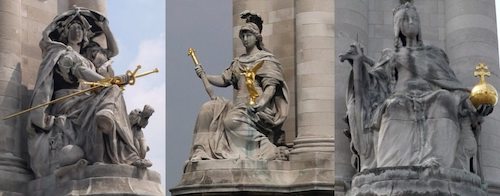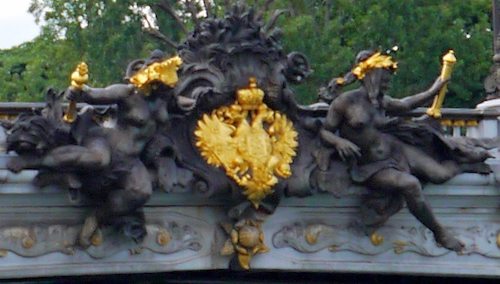The bridge, with its flashy art nouveau lamps, cherubs, nymphs and winged horses at either end, was built between 1896 and 1900. It is named after Tsar Alexander III, who had concluded the Franco-Russian Alliance in 1892. His son Nicholas II laid the foundation stone in October 1896. The style of the bridge reflects that of the Grand Palais, to which it leads on the right bank.
The bridge was built by the engineers Jean Résal and Amédée d’Alby and inaugurated in 1900 for the Universal Exhibition (as were the nearby Grand Palais and Petit Palais).
Four gilt-bronze statues of Fames watch over the bridge, supported on massive 17-meter columns that provide stabilizing counterweight for the arch, without interfering with monumental views. The columns are crowned by Fames restraining Pegasus : on the right bank, Renommée des Sciences (“Fame of the Sciences” lower left) and the Renommée des Arts (“Fame of the Arts” upper right) both by Emmanuel Frémiet and on the left bank the Renommée de la Gare (“Fame of War” upper left) by Pierre Granet and the Renommée au Combat (“Fame of Combat”) lower right) by Clément Steiner. There is a lot of misinformation on the web concerning both the names of these pieces (“fame of commerce” for fame of war” and “fame of industry” for “fame of combat) and attributions. I think I have it right, in any case the statues are beautiful.
At the base of the columns are more statues as seen above. They are La France Contemporaine (“Contemporary France”) by Gustave Michel (this statue is pretty eroded and missing the gold ornaments, I did not include it) and France de Charlemagne (“France of Charlemagne” right above) by Alfred Lenoir on the right bank and France de la Renaissance (“France of the Renaissance” left above) by Jules Coutan and La France de Louis XIV (“France of Louis XIV” above center) by Laurent Marqueste on the left bank.
There are so many sculpteral details on this bridge, it is hard to even take pictures of all of them, like this little sculpture at the base of the pillars.
I love these lions, the idea of a child mounting the lion like a horse is very appealing. Around the lion’s neck is a garland of flowers and child seems to have a pillow to help him get high enough to get on. There are two lions on each side of the bridge. The lions groups are by Georges Gardet.
Here we have a cherub with a triton on top of a very large fish, these cherub sculptures are near the ends on both side of the bridge.
The bridge was meant to be appreciated as much from the outside as when you actually cross the bridge, perhaps more. Here we see gold details of the side of the bridge with faces connected by garlands.
This is the outward side of the center (above) and the side inward toward pedestrians and traffic.
This is the back of the same carving.
Here is a side view.
Above to the left is a plaque to the builders, center is the outward side of the name plaque seen at the beginning of the post and to the left a close up of one of the art nuveaux lamps. In the film Midnight in Paris, the bridge is depicted in multiple scenes, including the final one. I love this bridge, it seems to personify Paeis at the turn of the century and even today.















